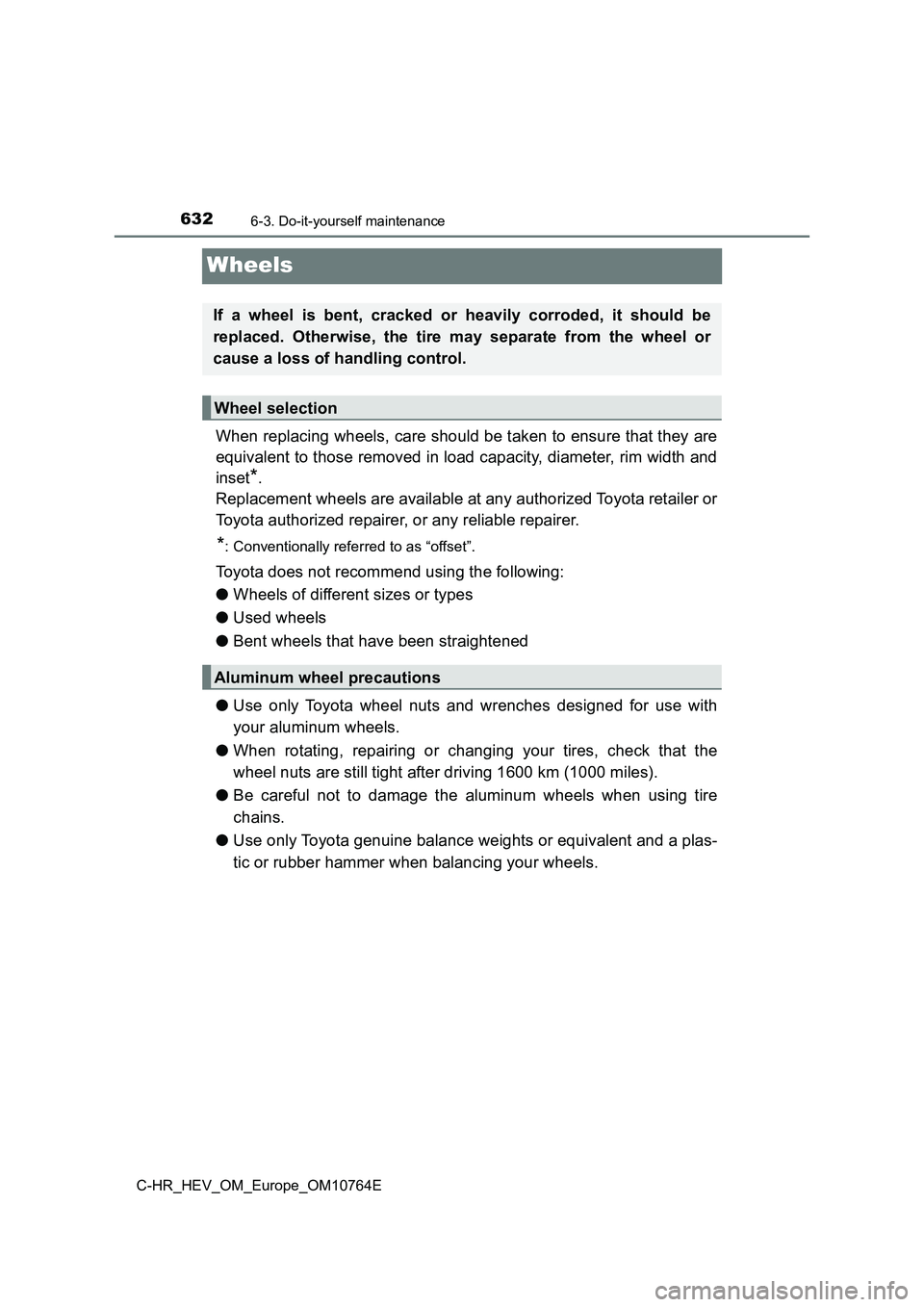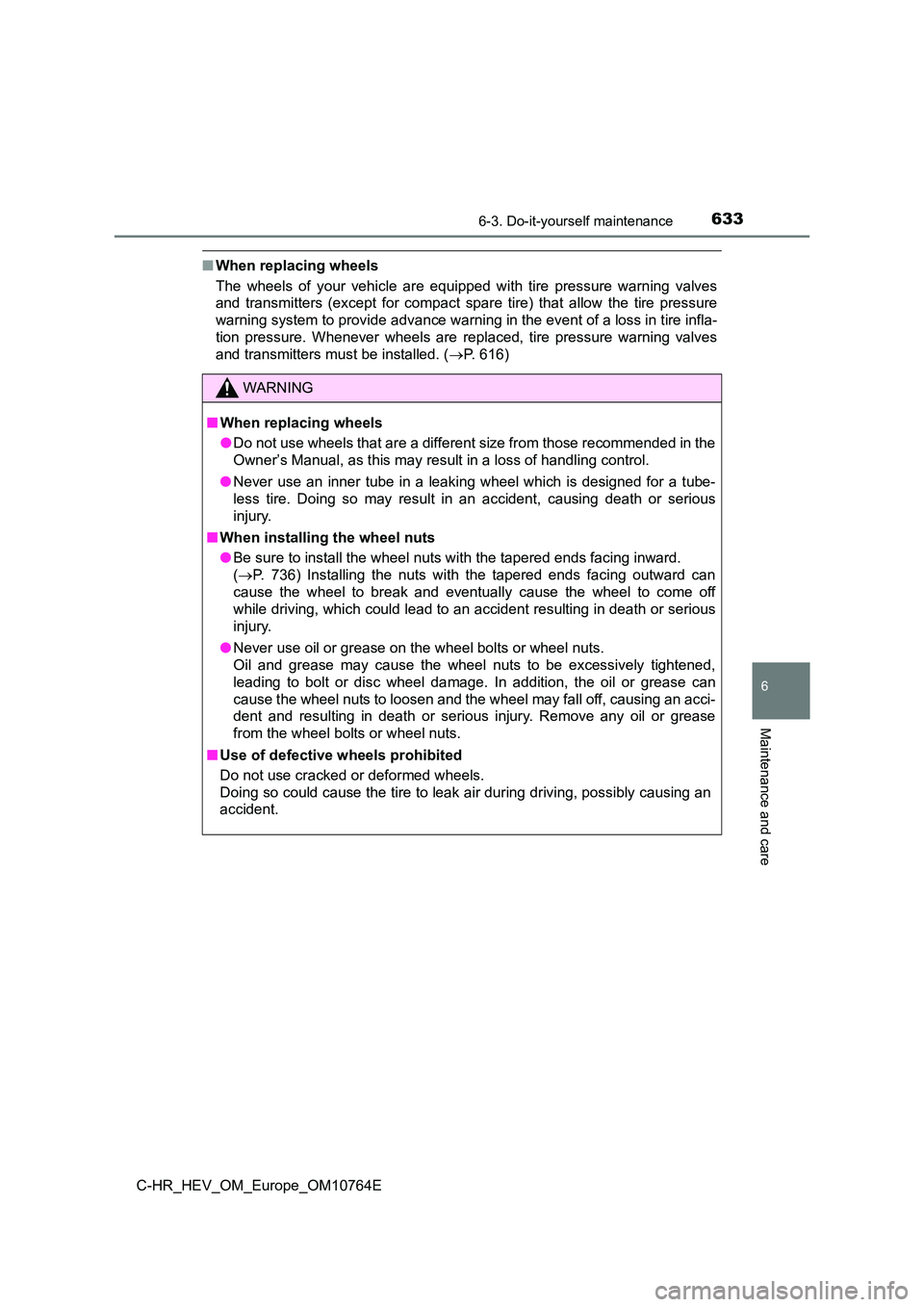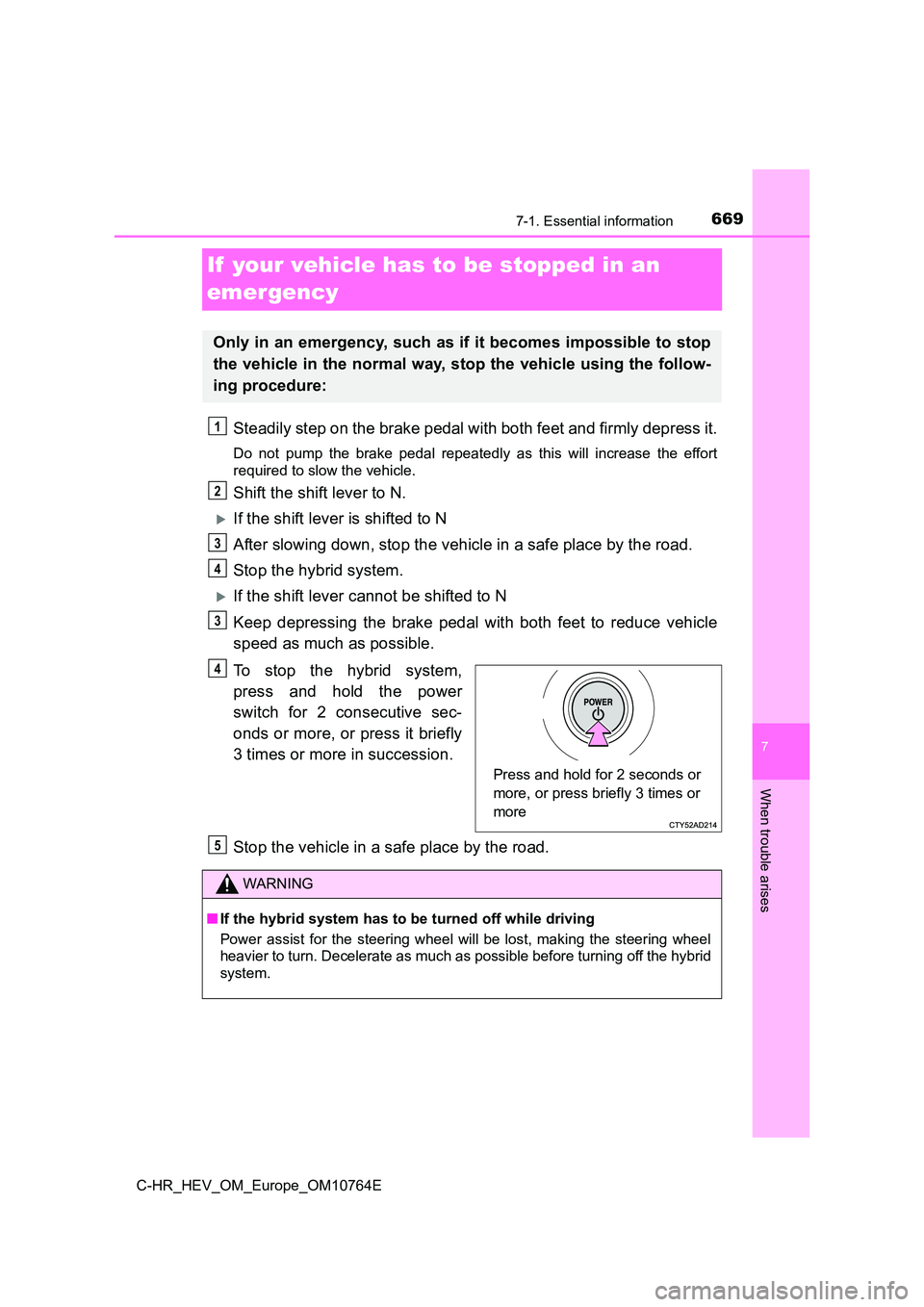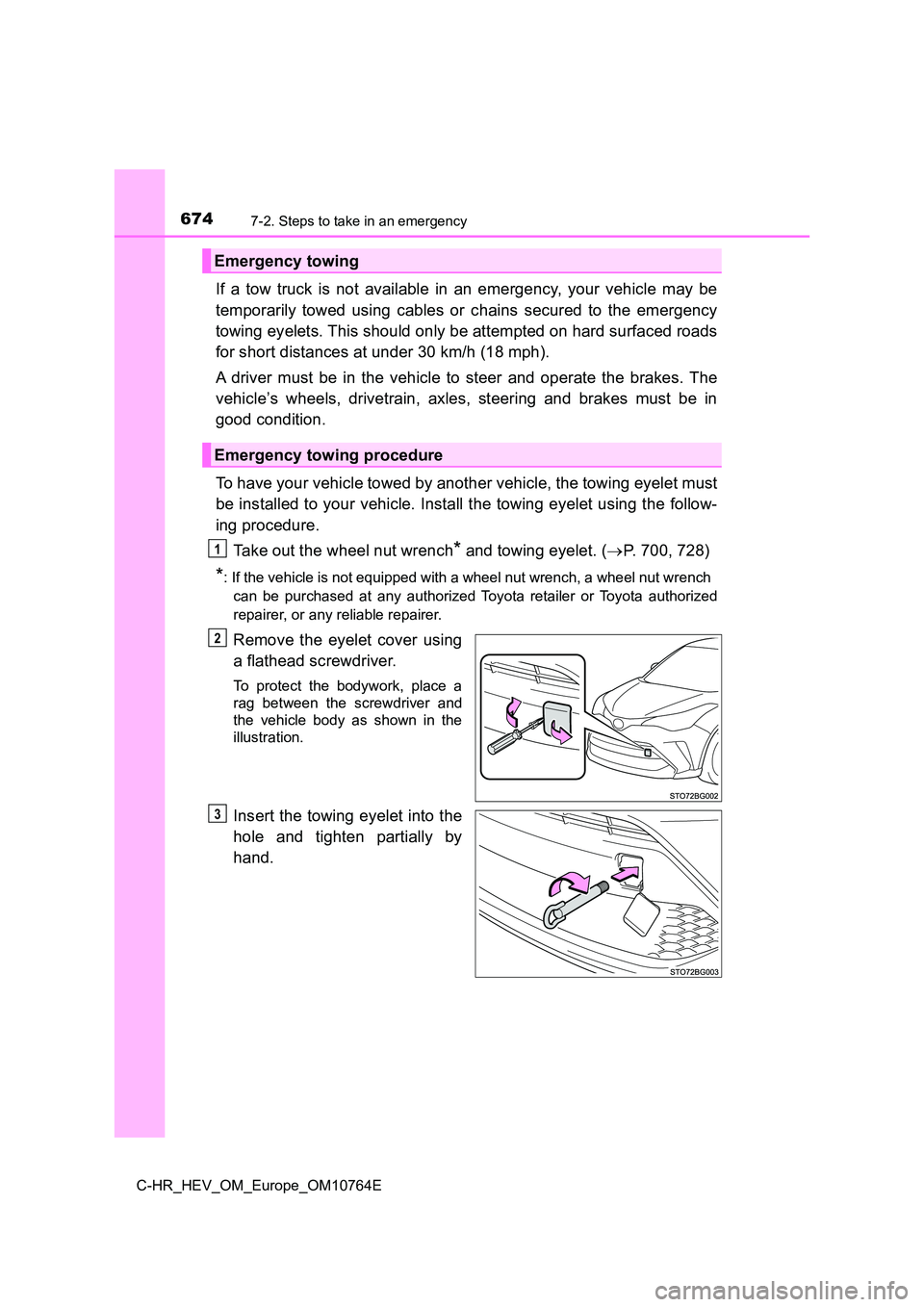Page 633 of 814
6316-3. Do-it-yourself maintenance
C-HR_HEV_OM_Europe_OM10764E
6
Maintenance and care
WARNING
■Proper inflation is critical to save tire performance
Keep your tires properly inflated.
If the tires are not properly inflated, the following condition s may occur
which could lead to an accident resulting in death or serious i njury:
● Excessive wear
● Uneven wear
● Poor handling
● Possibility of blowouts resulting from overheated tires
● Air leaking from between tire and wheel
● Wheel deformation and/or tire damage
● Greater possibility of tire damage while driving (due to road hazards,
expansion joints, sharp edges in the road, etc.)
NOTICE
■ When inspecting and adjusting tire inflation pressure
Be sure to put the tire valve caps back on.
If a valve cap is not installed, dirt or moisture may get into the valve and
cause an air leak, resulting in decreased tire inflation pressu re.
Page 634 of 814

6326-3. Do-it-yourself maintenance
C-HR_HEV_OM_Europe_OM10764E
Wheels
When replacing wheels, care should be taken to ensure that they are
equivalent to those removed in load capacity, diameter, rim wid th and
inset*.
Replacement wheels are available at any authorized Toyota retai ler or
Toyota authorized repairer, or any reliable repairer.
*: Conventionally referred to as “offset”.
Toyota does not recommend using the following:
● Wheels of different sizes or types
● Used wheels
● Bent wheels that have been straightened
● Use only Toyota wheel nuts and wrenches designed for use with
your aluminum wheels.
● When rotating, repairing or changing your tires, check that the
wheel nuts are still tight after driving 1600 km (1000 miles).
● Be careful not to damage the aluminum wheels when using tire
chains.
● Use only Toyota genuine balance weights or equivalent and a plas-
tic or rubber hammer when balancing your wheels.
If a wheel is bent, cracked or heavily corroded, it should be
replaced. Otherwise, the tire may separate from the wheel or
cause a loss of handling control.
Wheel selection
Aluminum wheel precautions
Page 635 of 814

6336-3. Do-it-yourself maintenance
C-HR_HEV_OM_Europe_OM10764E
6
Maintenance and care
■When replacing wheels
The wheels of your vehicle are equipped with tire pressure warn ing valves
and transmitters (except for compact spare tire) that allow the tire pressure
warning system to provide advance warning in the event of a los s in tire infla-
tion pressure. Whenever wheels are replaced, tire pressure warning valves
and transmitters must be installed. ( P. 616)
WARNING
■When replacing wheels
● Do not use wheels that are a different size from those recommended in the
Owner’s Manual, as this may resu lt in a loss of handling control.
● Never use an inner tube in a leaking wheel which is designed for a tube-
less tire. Doing so may result in an accident, causing death or serious
injury.
■ When installing the wheel nuts
● Be sure to install the wheel nuts with the tapered ends facing inward.
( P. 736) Installing the nuts with the tapered ends facing outward can
cause the wheel to break and eventually cause the wheel to come off
while driving, which could lead to an accident resulting in dea th or serious
injury.
● Never use oil or grease on the wheel bolts or wheel nuts.
Oil and grease may cause the wheel nuts to be excessively tight ened,
leading to bolt or disc wheel damage. In addition, the oil or grease can
cause the wheel nuts to loosen and the wheel may fall off, caus ing an acci-
dent and resulting in death or serious injury. Remove any oil o r grease
from the wheel bolts or wheel nuts.
■ Use of defective wheels prohibited
Do not use cracked or deformed wheels.
Doing so could cause the tire to leak air during driving, possi bly causing an
accident.
Page 636 of 814
6346-3. Do-it-yourself maintenance
C-HR_HEV_OM_Europe_OM10764E
NOTICE
■Replacing tire pressure warning valves and transmitters
● Because tire repair or replacement may affect the tire pressure warning
valves and transmitters, make sure to have tires serviced by an y autho-
rized Toyota retailer or Toyota authorized repairer, or any rel iable repairer
or other qualified service shop. In addition, make sure to purc hase your
tire pressure warning valves and transmitters at any authorized Toyota
retailer or Toyota authorized repairer, or any reliable repaire r.
● Ensure that only genuine Toyota wheels are used on your vehicle.
Tire pressure warning valves and transmitters may not work prop erly with
non-genuine wheels.
Page 671 of 814

6697-1. Essential information
C-HR_HEV_OM_Europe_OM10764E
7
When trouble arises
If your vehicle has to be stopped in an
emergency
Steadily step on the brake pedal with both feet and firmly depr ess it.
Do not pump the brake pedal repeatedly as this will increase the effort
required to slow the vehicle.
Shift the shift lever to N.
If the shift lever is shifted to N
After slowing down, stop the vehicle in a safe place by the roa d.
Stop the hybrid system.
If the shift lever cannot be shifted to N
Keep depressing the brake pedal with both feet to reduce vehicl e
speed as much as possible.
To stop the hybrid system,
press and hold the power
switch for 2 consecutive sec-
onds or more, or press it briefly
3 times or more in succession.
Stop the vehicle in a safe place by the road.
Only in an emergency, such as if it becomes impossible to stop
the vehicle in the normal way, stop the vehicle using the follo w-
ing procedure:
1
2
3
4
3
Press and hold for 2 seconds or
more, or press briefly 3 times or
more
Q
WARNING
■ If the hybrid system has to be turned off while driving
Power assist for the steering wheel will be lost, making the st eering wheel
heavier to turn. Decelerate as much as possible before turning off the hybrid
system.
5
Page 674 of 814
6727-2. Steps to take in an emergency
C-HR_HEV_OM_Europe_OM10764E
If your vehicle needs to be towed
The following may indicate a problem with your hybrid transmission.
Contact any authorized Toyota retailer or Toyota authorized rep airer,
or any reliable repairer or commercial towing service before to wing.
● The hybrid system warning message is shown on the multi-informa-
tion display and the vehicle does not move.
● The vehicle makes an abnormal sound.
If towing is necessary, we recommend having your vehicle
towed by any authorized Toyota retailer or Toyota authorized
repairer, or any reliable repairer or commercial towing service ,
using a wheel-lift type truck or flatbed truck.
Use a safety chain system for all towing, and abide by all stat e/
provincial and local laws.
Situations when it is necessary to contact dealers before towin g
Page 675 of 814
6737-2. Steps to take in an emergency
C-HR_HEV_OM_Europe_OM10764E
7
When trouble arises
When using a flat-bed truck to transport the vehicle, use tire strapping
belts. Refer to the owner’s manual of the flat-bed truck for th e tire
strapping method.
In order to suppress vehicle movement during transportation, se t the
parking brake and turn the power switch off
Towing with a wheel-lift type truck
From the frontFrom the rear
Release the parking brake.
Turn automatic mode off.
(P. 3 2 3 )
Use a towing dolly under the
front wheels.
Using a flatbed truck
Page 676 of 814

6747-2. Steps to take in an emergency
C-HR_HEV_OM_Europe_OM10764E
If a tow truck is not available in an emergency, your vehicle may be
temporarily towed using cables or chains secured to the emergen cy
towing eyelets. This should only be attempted on hard surfaced roads
for short distances at under 30 km/h (18 mph).
A driver must be in the vehicle to steer and operate the brakes . The
vehicle’s wheels, drivetrain, axles, steering and brakes must b e in
good condition.
To h ave yo urTo hav e y our v ehicle towed by an other v ehicle, the towing ey elet mus t be installed to y our v ehicle. Ins tall the towing ey elet us in g the following proced ure. ve hicle towe d by another vehicle, the towing eyelet must be installed to your vehicle. Install the towing eyelet using the following procedure.
To have your vehicle towed by another vehicle, the towing eyelet must
be installed to your vehicle. Install the towing eyelet using t he follow-
ing procedure.
Take out the wheel nut wrench* and towing eyelet. ( P. 700, 728)
*: If the vehicle is not equipped with a wheel nut wrench, a wheel nut wrench
can be purchased at any authorized Toyota retailer or Toyota au thorized
repairer, or any reliable repairer.
Remove the eyelet cover using
a flathead screwdriver.
To protect the bodywork, place a
rag between the screwdriver and
the vehicle body as shown in the
illustration.
Insert the towing eyelet into the
hole and tighten partially by
hand.
Emergency towing
Emergency towing procedure
1
2
3